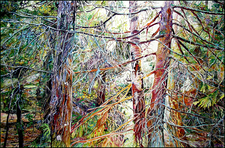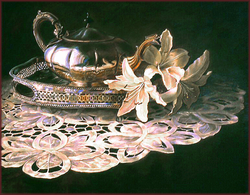 'Light in the Forest' 2010
'Light in the Forest' 2010 I'm often asked what do I do about inspiration and people are often surprised that I don't sit around and wait for it. .The answer is that my job as a professional artist is to be working consistently in my studio. This means every day. I'm not playing or waiting for inspiration though there may be times when I experiment. I'm working towards a goal, whether it's a commission, or to build a body of work, to promote or just be a better artist. I don't just paint when the spirit moves me or have the time but I work in the studio because that is what I do. I am an artist and artists make art consistently. I do spend time thinking and planning but production is the most important. If I don't actually make art, I have nothing except a bunch of good ideas or worse, no ideas because I'm not focused on the work. It doesn't mean that inspiration doesn't exist or that some work is not more inspired than others, it merely means that I must work each day regardless of whether I feel like it or not. It's the process of working that gives rise to new ideas. With luck and steady application, I can expect inspired patches from time to time. As the American contemporary realist Chuck Close said 'Amateurs sit and wait for inspiration, the rest of us just get up and got to work.'

 RSS Feed
RSS Feed
